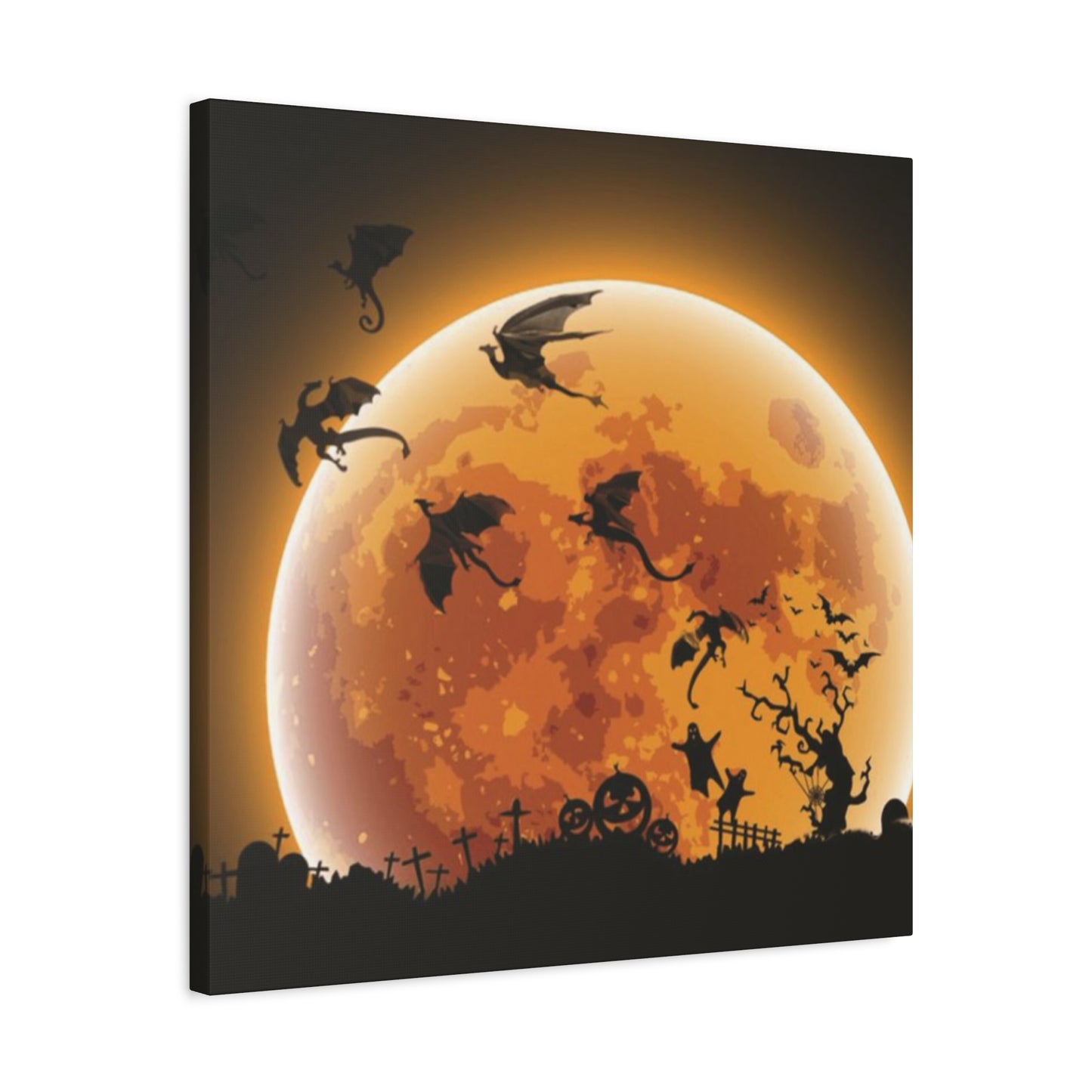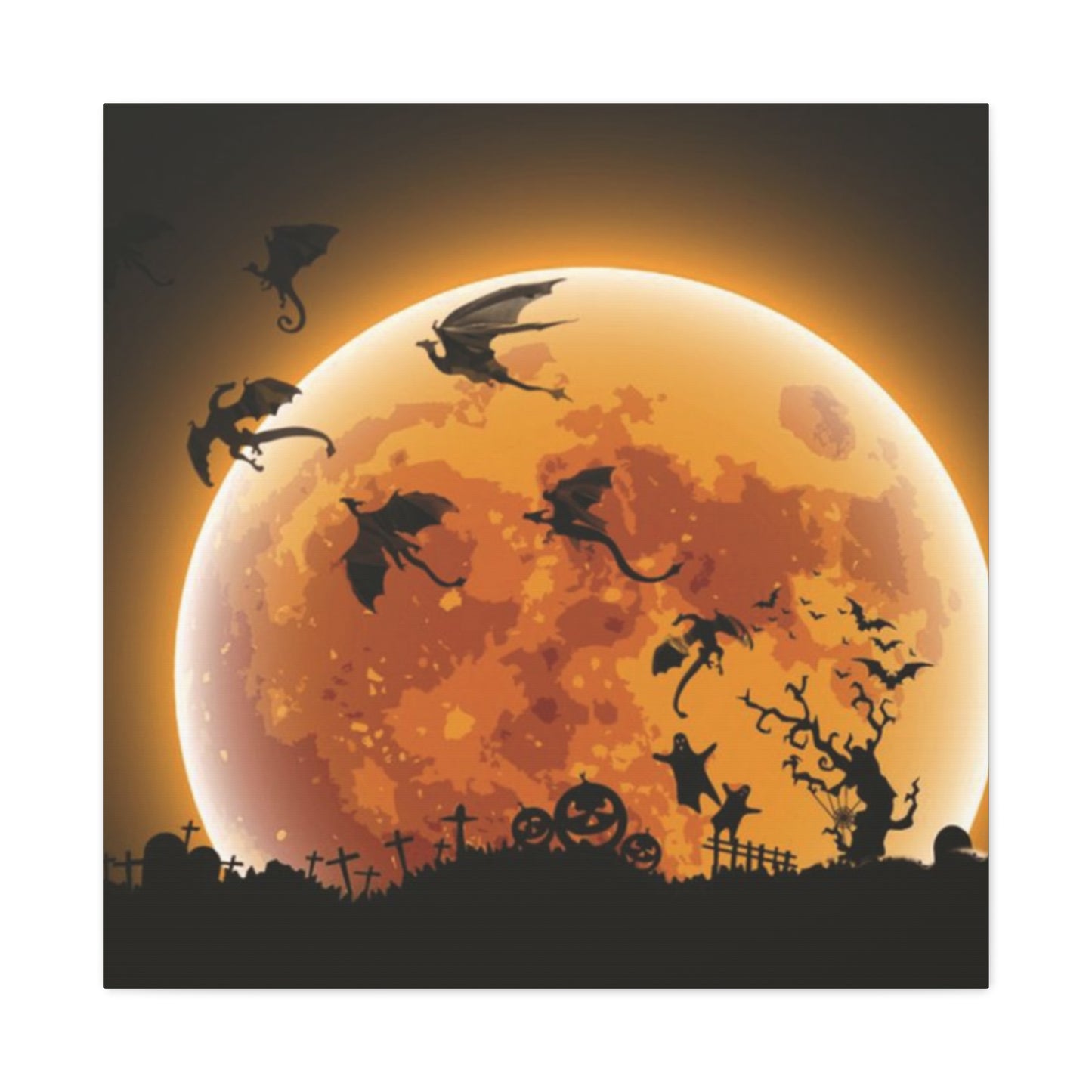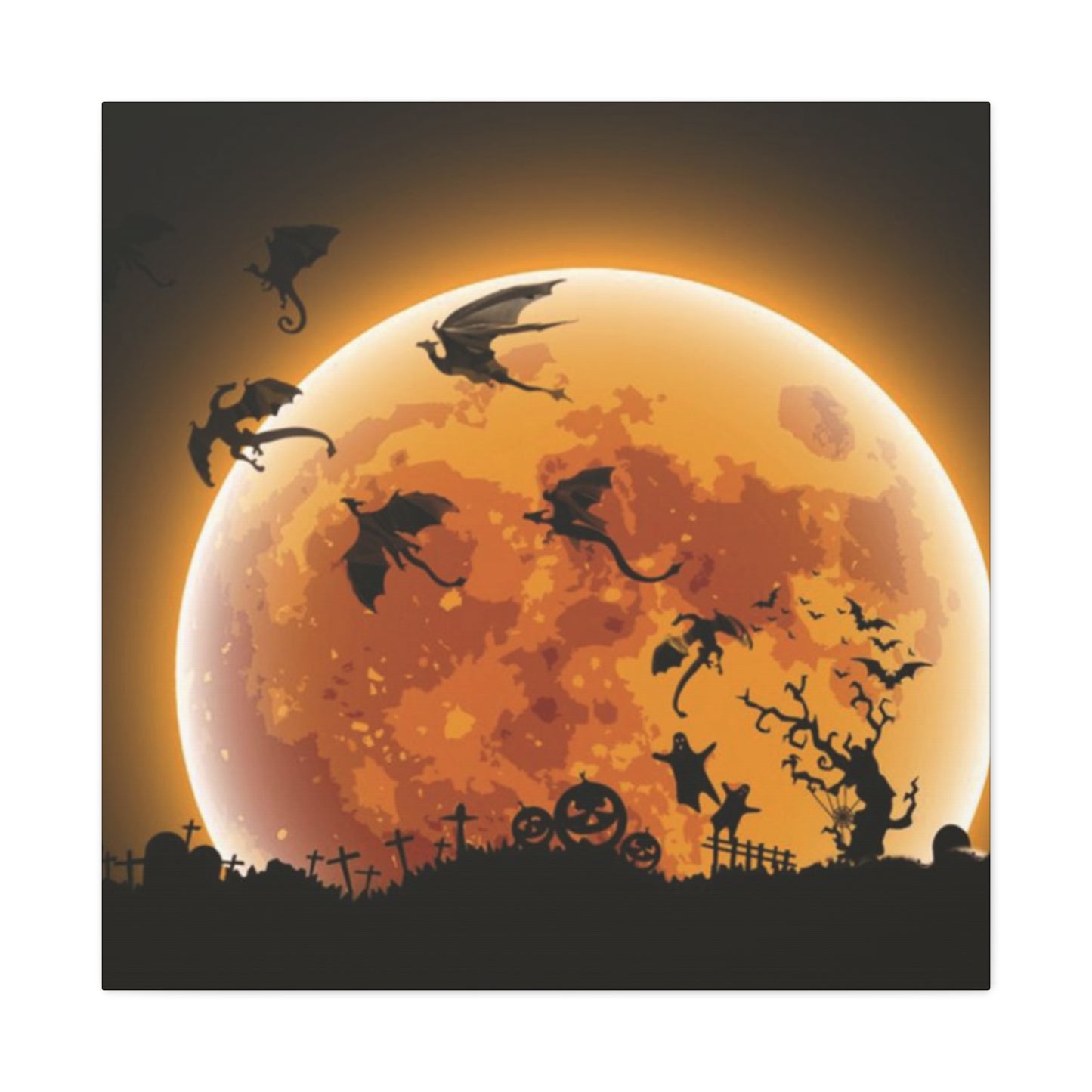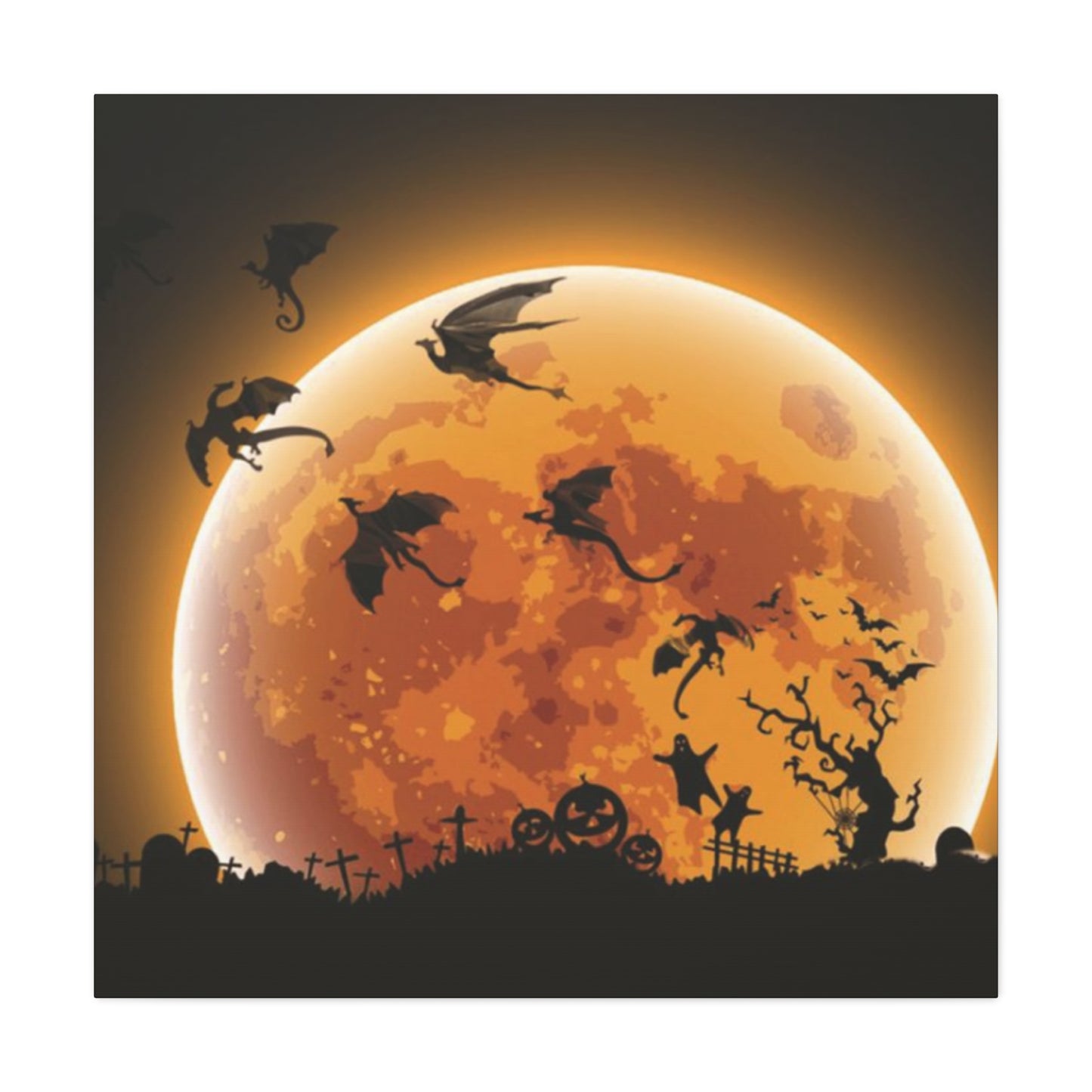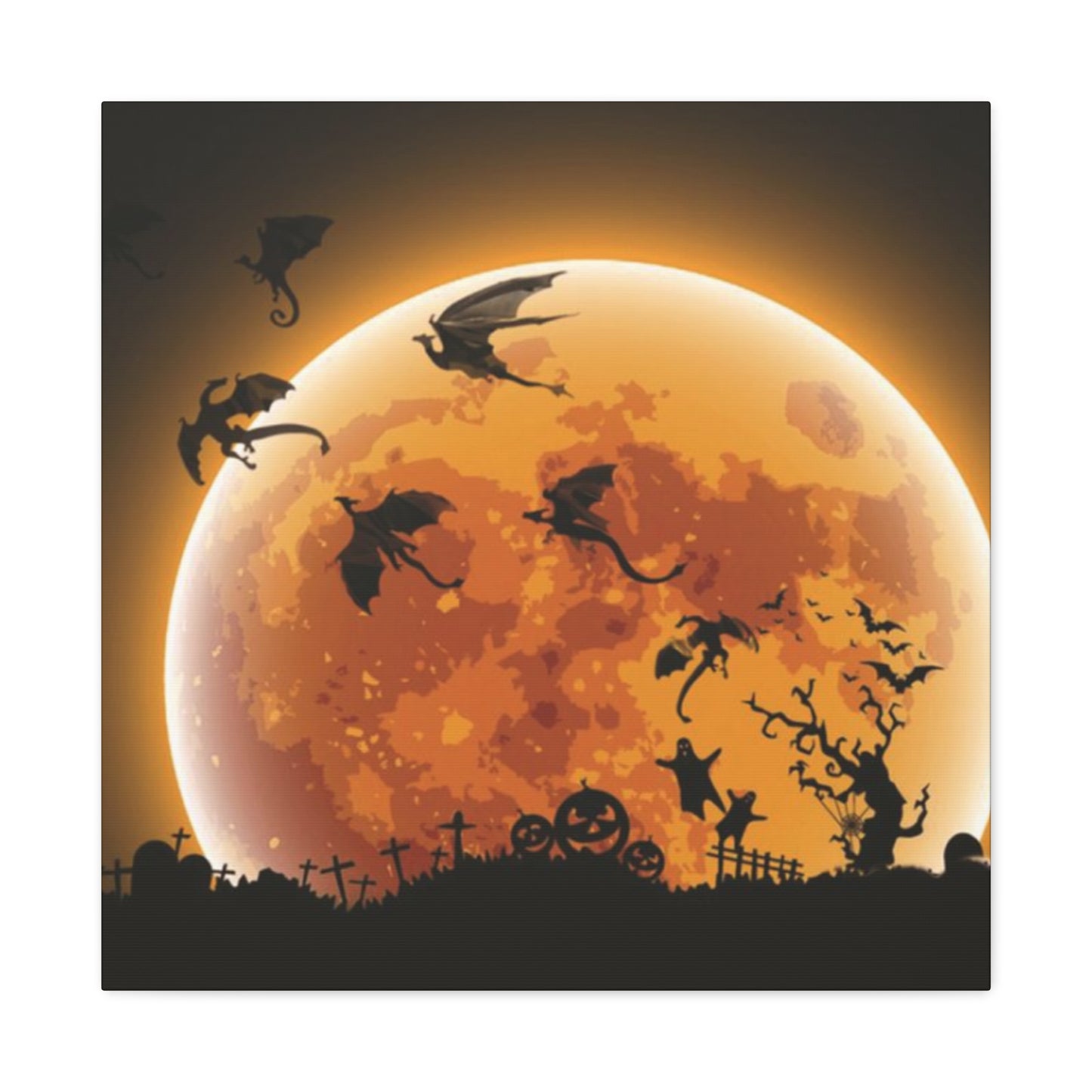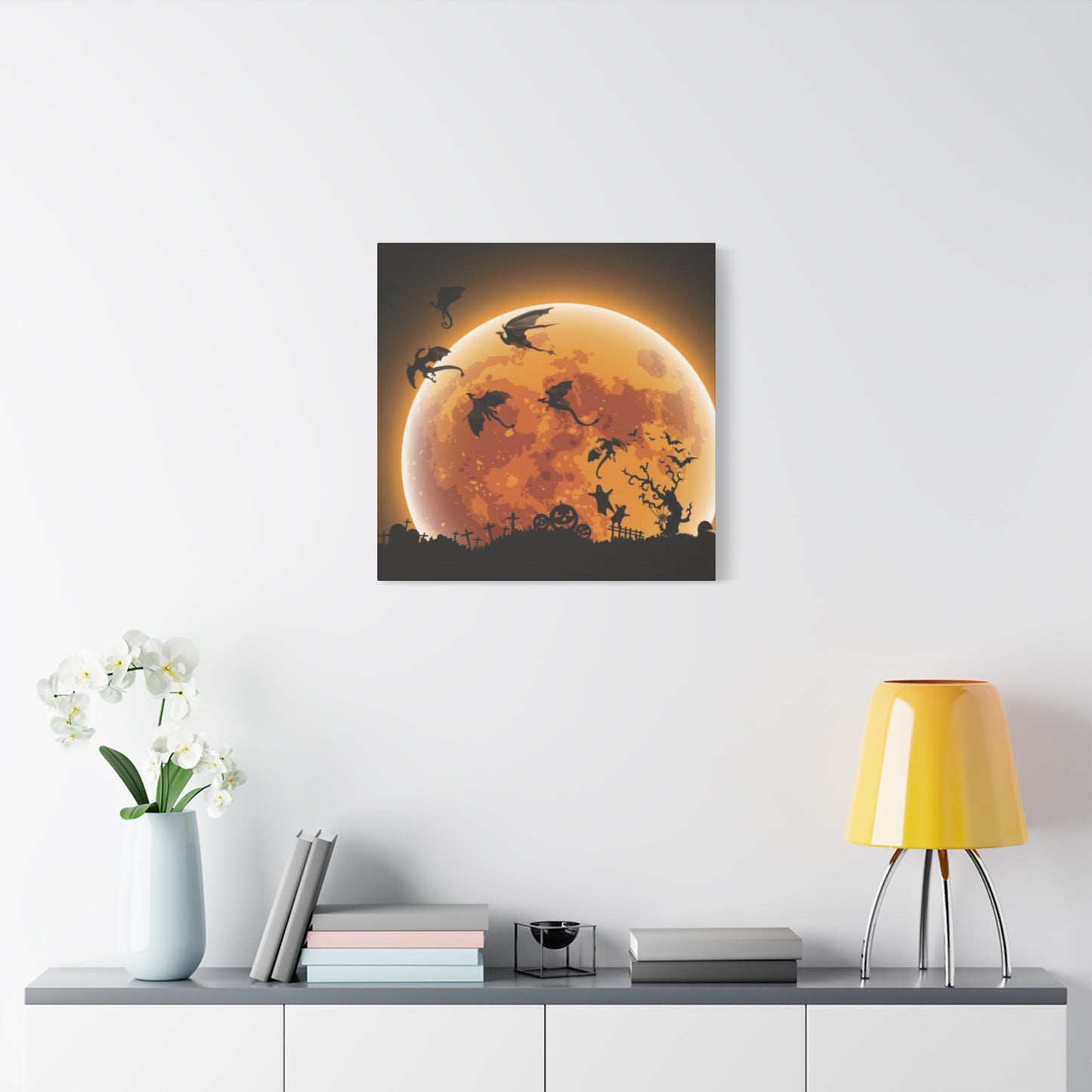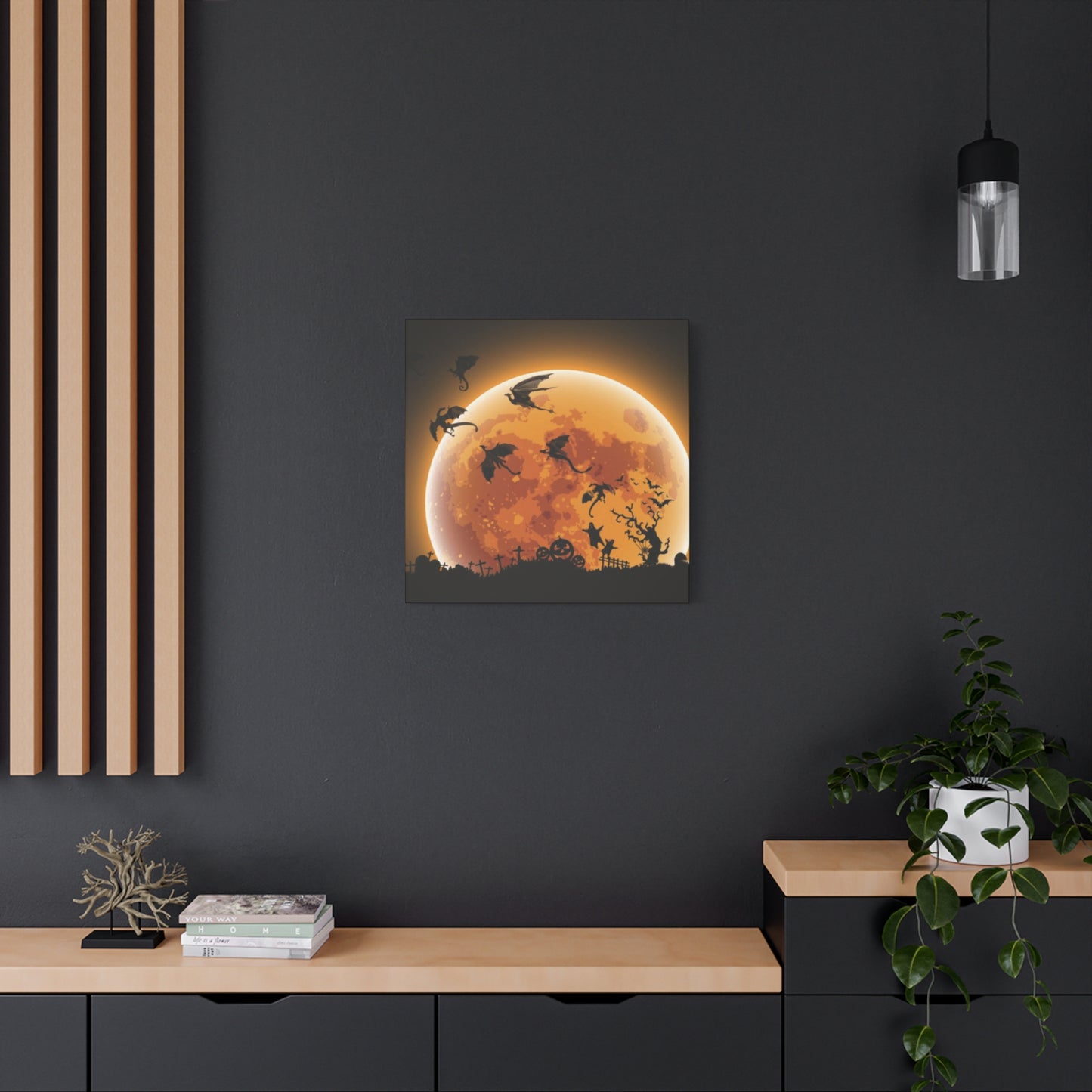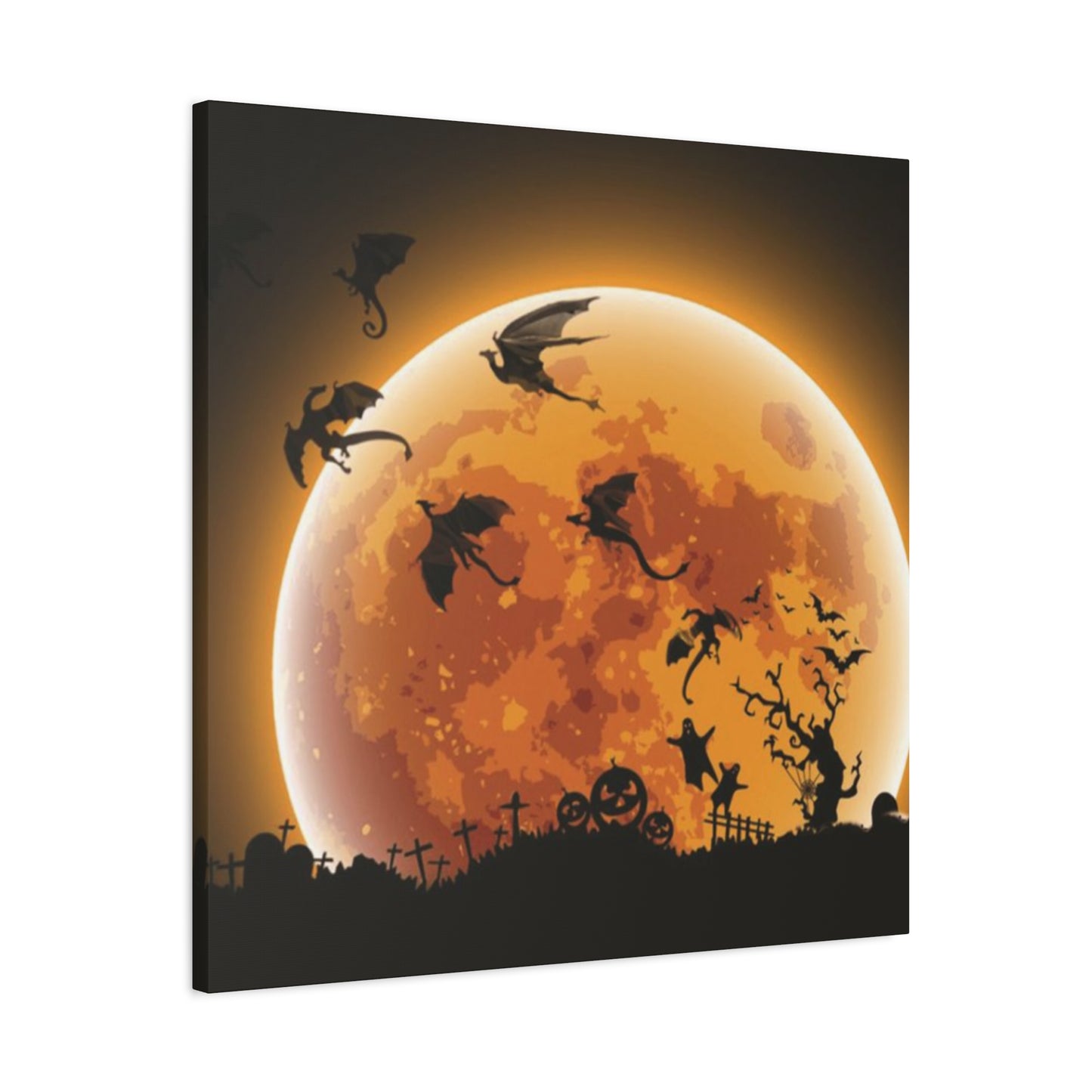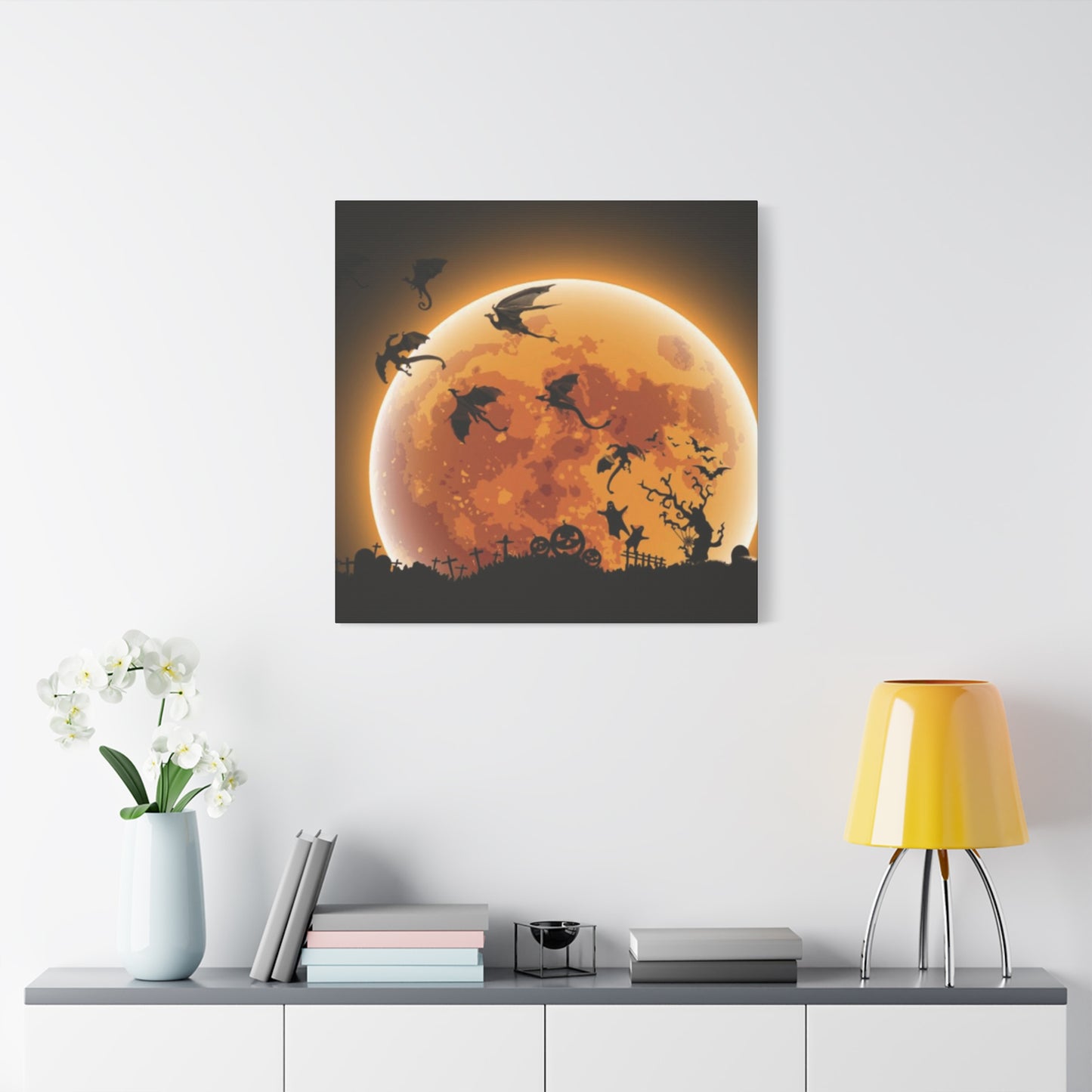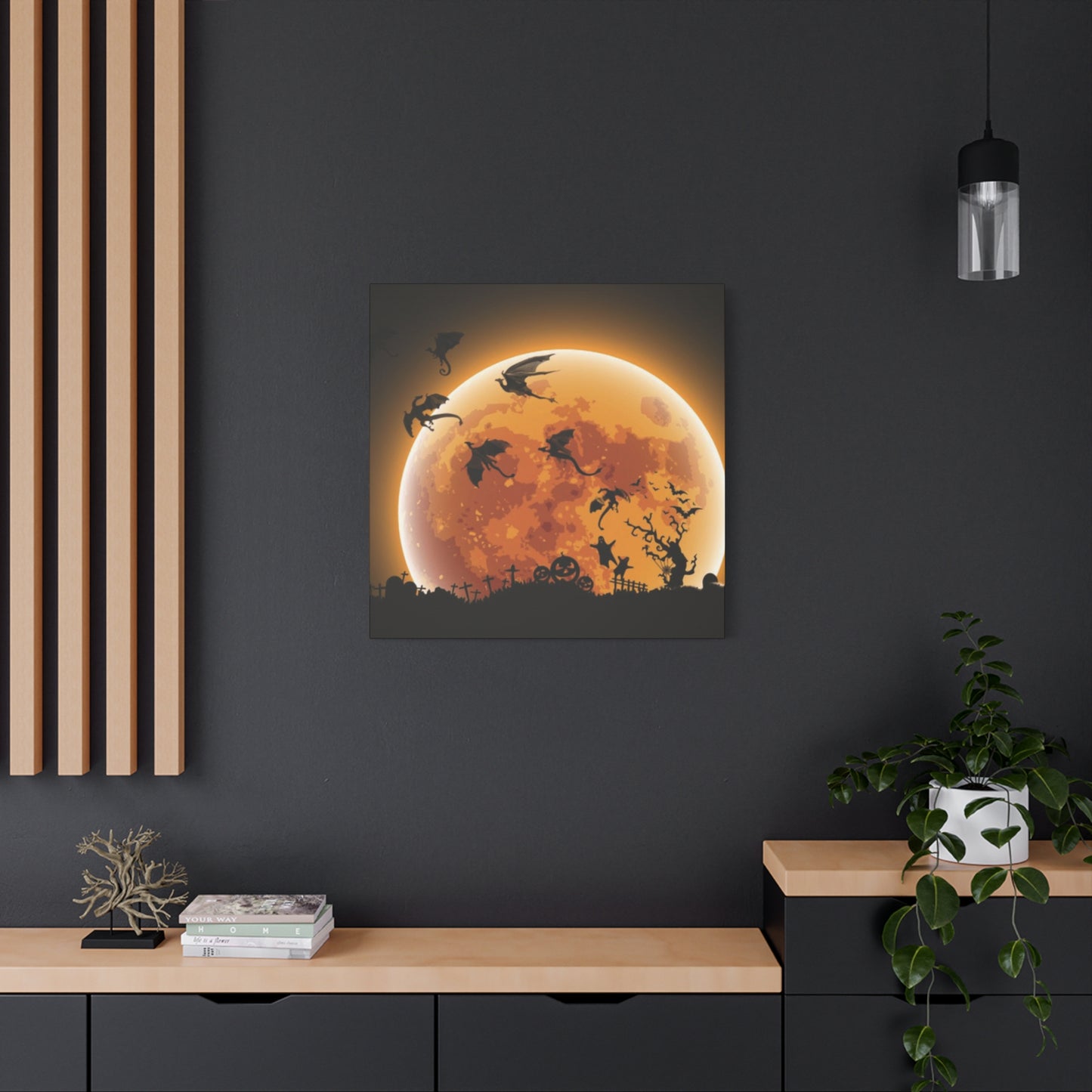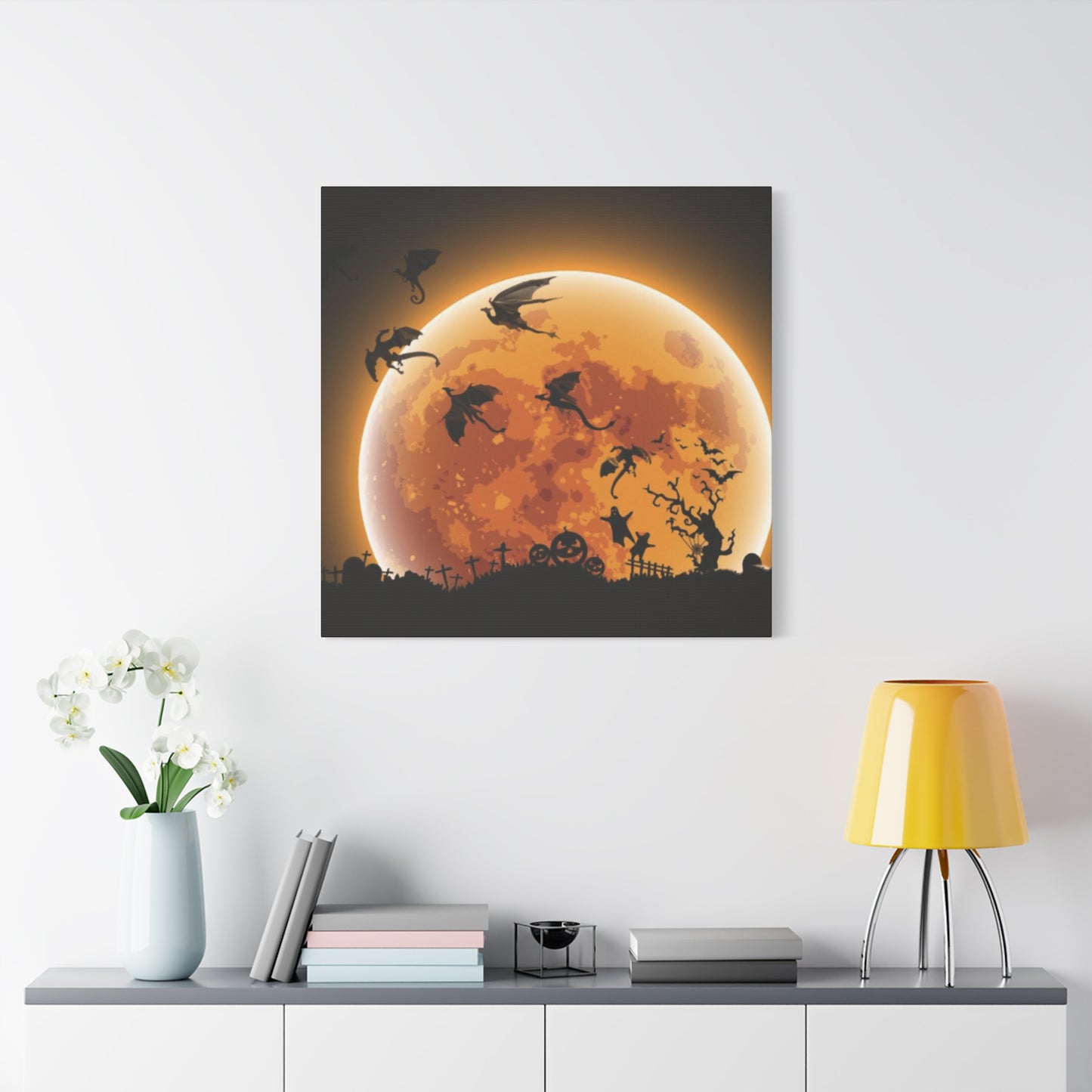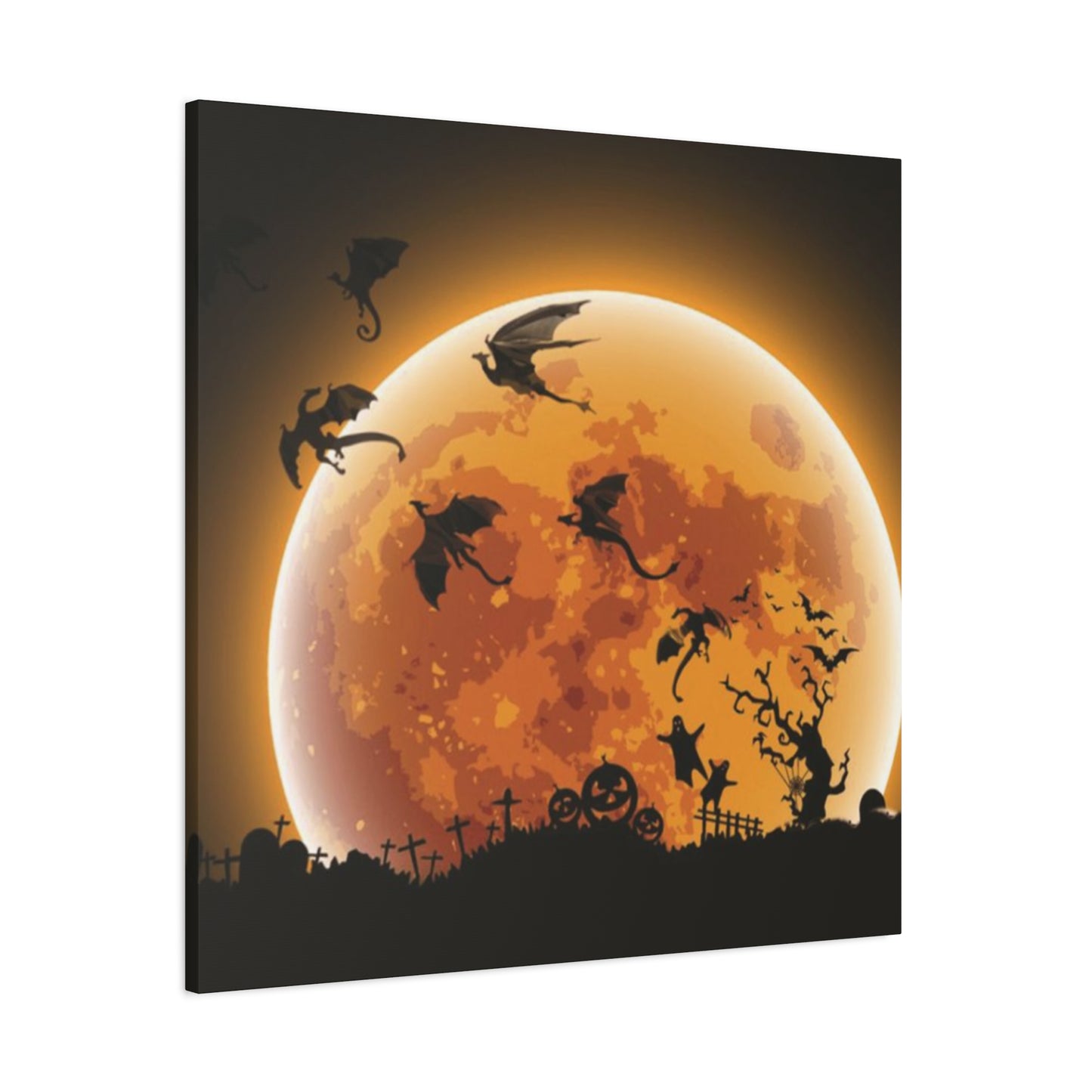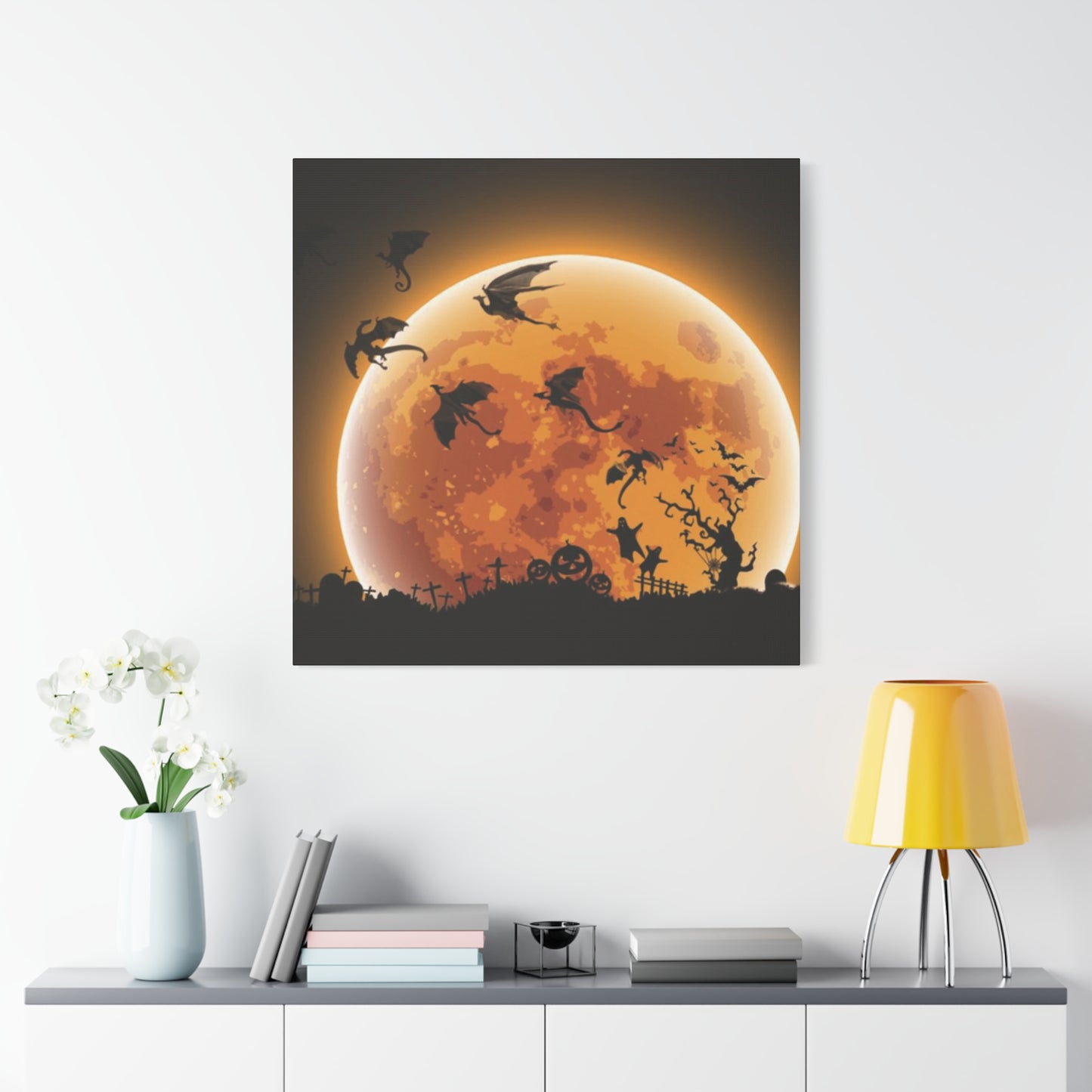Enchanting Halloween Dragon Wall Art: Moonlit Masterpieces for Spooky Decor
The captivating allure of Halloween brings forth an extraordinary opportunity to blend mythical creatures with seasonal enchantment through stunning dragon wall art illuminated by the mystical glow of autumn's full moon. These magnificent artistic creations transport viewers into a realm where ancient legends meet contemporary holiday traditions, creating an atmosphere that perfectly captures the essence of October's most celebrated night.
Halloween dragon wall art featuring lunar themes represents more than mere decoration; it embodies the profound connection between supernatural folklore and seasonal transformation. The combination of these powerful mythological beings with the haunting beauty of moonlit nights creates visual narratives that speak to our deepest fascination with mystery, magic, and the unknown. Each piece tells a story of ancient wisdom, primal power, and the eternal dance between light and shadow that defines the Halloween season.
The growing popularity of dragon-themed Halloween decorations reflects our collective desire to embrace both elegance and eeriness in our seasonal displays. These artworks serve as focal points that command attention while seamlessly integrating with broader Halloween themes. From elaborate paintings depicting majestic creatures soaring beneath luminous moons to minimalist silhouettes that capture the essence of draconic power, these pieces offer endless possibilities for creating memorable seasonal atmospheres.
Contemporary artists and decorators increasingly recognize the versatility of dragon imagery in Halloween contexts. Unlike traditional horror motifs that may feel limiting or overly intense, dragons offer a perfect balance of mystique and sophistication. They can appear fierce and formidable or graceful and magical, depending on artistic interpretation and stylistic approach. This adaptability makes dragon wall art an excellent choice for those seeking Halloween decorations that maintain appeal beyond the October season.
The artistic journey of creating or selecting dragon wall art for Halloween involves understanding the symbolic significance of these legendary creatures across various cultures. Dragons represent wisdom, protection, transformation, and elemental power elements that align beautifully with Halloween's themes of change, mystery, and supernatural presence. When combined with lunar imagery, these symbols create rich layers of meaning that enhance the visual impact of any decorative scheme.
Professional artists working in this genre often draw inspiration from multiple cultural traditions, blending Eastern dragon mythology with Western fantasy aesthetics. This cross-cultural approach produces unique interpretations that feel both familiar and exotic, appealing to diverse audiences while maintaining authentic artistic integrity. The resulting artworks often feature intricate details that reward close examination while maintaining strong visual impact from a distance.
The technical aspects of creating effective dragon wall art for Halloween require careful consideration of color palettes, composition, and lighting effects. Artists must balance the need for dramatic visual impact with the subtlety required to create lasting appeal. The interplay between warm dragon colors and cool moonlight creates natural contrast that enhances the mysterious atmosphere essential to effective Halloween decoration.
Full Moon and Dragon: Halloween Symbols
The symbolic relationship between dragons and full moons in Halloween imagery runs deeper than mere aesthetic appeal, touching upon ancient mythological connections that span cultures and centuries. Full moons have long been associated with transformation, heightened supernatural activity, and the thinning of veils between worlds concepts that align perfectly with both dragon lore and Halloween traditions. This symbolic synergy creates powerful visual metaphors that resonate with viewers on subconscious levels.
In Celtic mythology, dragons were guardians of sacred knowledge and treasures, often depicted as creatures of great wisdom who possessed deep understanding of cosmic cycles. The full moon represented the peak of lunar power, a time when magic was strongest and supernatural beings were most active. Halloween, rooted in the ancient Celtic festival of Samhain, marked the transition between seasons and the opening of doorways between worlds. The combination of these elements in wall art creates layers of meaning that enrich the viewing experience.
Asian dragon traditions offer another perspective on the moon-dragon connection, with lunar festivals celebrating the harmony between celestial bodies and earthbound creatures. Chinese and Japanese art frequently depicts dragons ascending toward or dancing around full moons, symbolizing the journey between earthly and heavenly realms. These cultural influences have profoundly shaped contemporary Halloween dragon art, providing rich visual vocabulary for modern artists to explore.
The psychological impact of full moon dragon imagery taps into primal human responses to both celestial phenomena and mythical creatures. The full moon triggers ancient instincts related to nocturnal awareness and heightened alertness, while dragons represent our fascination with power, mystery, and the untameable forces of nature. Together, they create artwork that speaks to deep-seated emotional responses while satisfying our appreciation for beauty and craftsmanship.
Modern interpretations of full moon dragon symbolism often incorporate elements from horror and fantasy genres, creating hybrid aesthetics that feel both traditional and contemporary. Artists might depict dragons as protective spirits watching over Halloween celebrations, or as mysterious entities emerging from moonlit mists. These varying interpretations allow for personalized approaches to Halloween decoration while maintaining connection to broader symbolic traditions.
The seasonal timing of Halloween coincides with some of the year's most dramatic full moons, when atmospheric conditions often create particularly striking lunar displays. This natural phenomenon provides authentic inspiration for artists working in this genre, encouraging them to capture the actual visual drama of October's night skies. Many successful pieces in this category draw directly from real astronomical events, lending authenticity to fantastical subject matter.
Color symbolism plays a crucial role in full moon dragon artwork, with silver, gold, and deep blues representing lunar qualities while reds, oranges, and purples evoke draconic power. The interplay between these color families creates dynamic visual tension that enhances the dramatic impact of Halloween displays. Successful artists learn to balance these elements to create harmonious compositions that maintain visual interest without becoming overwhelming.
Dragons Under the Halloween Moon
The artistic portrayal of dragons beneath Halloween moons requires sophisticated understanding of both creature design and atmospheric effects. These compositions must effectively convey the scale and majesty of mythical beasts while capturing the ethereal quality of moonlight filtering through autumn air. The challenge lies in creating believable interactions between fantastical subjects and realistic environmental elements.
Atmospheric perspective becomes particularly important when depicting dragons in moonlit scenes. Artists must consider how lunar light affects the visibility and coloration of distant objects, creating depth through careful manipulation of value and saturation. Dragons positioned closer to the viewer should appear more detailed and vibrant, while those in the background become increasingly mysterious and ethereal. This technique enhances the sense of vast, magical landscapes extending beyond the artwork's boundaries.
The positioning of dragons relative to the moon creates different narrative implications and visual dynamics. Dragons silhouetted against the lunar disc appear as pure forms emphasizing shape and gesture, while those illuminated by moonlight reveal surface textures and anatomical details. Some compositions feature multiple dragons at varying distances, creating complex spatial relationships that reward extended viewing.
Wing membrane translucency offers unique opportunities for creative lighting effects in moonlit dragon scenes. When positioned between the moon and viewer, dragon wings can filter and color the lunar light, creating spectacular displays reminiscent of stained glass windows. This technique adds layers of visual interest while reinforcing the magical qualities essential to effective Halloween imagery.
Environmental elements surrounding moonlit dragons contribute significantly to overall mood and storytelling. Bare autumn trees, swirling mists, abandoned ruins, or distant mountain ranges all serve to establish the Halloween setting while providing context for dragon activities. These background elements should complement rather than compete with the primary subjects, supporting the overall composition without creating visual confusion.
The behavioral aspects of dragons in Halloween moon settings offer rich opportunities for artistic expression. Some pieces might show dragons in flight, their powerful wings carrying them across luminous skies, while others depict them perched on castle towers or mountain peaks, serving as sentinels of the night. Each behavioral choice communicates different aspects of dragon nature and creates distinct emotional responses in viewers.
Seasonal indicators help establish the Halloween timeframe without relying solely on obvious holiday symbols. Falling leaves caught in moonbeams, bare branches creating intricate shadows, or the golden glow characteristic of autumn foliage all contribute to seasonal identification. These subtle environmental cues enhance the Halloween connection while maintaining the timeless quality that makes dragon art appealing year-round.
Spooky Full Moon Dragon Scenes
Creating genuinely spooky dragon scenes requires careful balance between frightening elements and artistic beauty. The goal is to evoke thrills and excitement rather than genuine terror, maintaining the playful spirit of Halloween while delivering satisfying dramatic impact. This balance challenges artists to explore the darker aspects of dragon mythology without losing the sense of wonder that makes these creatures appealing.
Fog and mist effects prove particularly effective in spooky dragon compositions, obscuring portions of the creature while revealing others in dramatic fashion. These atmospheric elements create mystery and suggest hidden dangers while providing opportunities for creative lighting effects. Skillfully rendered mist can transform familiar dragon forms into something more enigmatic and unsettling.
The integration of gothic architectural elements enhances the spooky atmosphere of dragon moon scenes. Crumbling castles, ancient towers, weathered gargoyles, and ornate cemetery gates all provide appropriate settings for supernatural encounters. These structures offer visual anchors that help establish scale while contributing to the overall mood through their associations with decay, abandonment, and forgotten histories.
Color temperature manipulation contributes significantly to spooky atmospheres in dragon artwork. Cool blues and purples suggest supernatural presence and otherworldly environments, while strategic use of warmer tones in dragon eyes, flames, or magical effects creates focal points and suggests hidden power. The contrast between cool environmental tones and warm creature details enhances both the mysterious atmosphere and the sense of dragon vitality.
Lighting direction and intensity dramatically affect the spooky quality of dragon scenes. Backlighting creates dramatic silhouettes and emphasizes the imposing shapes of dragons, while side lighting reveals surface textures and anatomical details that might appear more threatening. Unconventional lighting angles can make familiar dragon forms appear more alien and unsettling.
The inclusion of smaller supernatural elements adds layers of spookiness without overwhelming the primary dragon subjects. Bats silhouetted against the moon, glowing eyes peering from shadows, spectral figures in distant ruins, or mysterious lights floating through the scene all contribute to the Halloween atmosphere. These elements should remain subtle enough to avoid cluttering the composition while adding richness to the overall narrative.
Weather effects provide additional opportunities for creating spooky dragon scenes. Storm clouds gathering around the full moon, lightning illuminating dragon forms, or supernatural winds whipping through the composition all add drama and energy. These dynamic elements help convey the sense of supernatural forces at work while creating visual excitement that holds viewer attention.
Using Dark Colors in Halloween Dragon Art
The strategic application of dark color palettes in Halloween dragon art requires sophisticated understanding of value relationships and color theory. Dark colors serve multiple purposes beyond mere atmospheric creation; they help establish mood, guide viewer attention, and create the dramatic contrasts essential to effective seasonal artwork. Mastering these techniques enables artists to create powerful visual statements that capture the essence of Halloween mystique.
Black, the foundational color of Halloween palettes, offers infinite variations and applications in dragon art. Pure black creates dramatic silhouettes and sharp contrasts, while subtle variations in black tones can suggest different materials, textures, and atmospheric conditions. Artists working in this genre learn to distinguish between dozens of black variations, each serving specific compositional purposes.
Deep purples and midnight blues provide rich alternatives to straight black while maintaining the dark aesthetic essential to Halloween imagery. These colors suggest supernatural presence and otherworldly environments while offering more nuanced opportunities for color interaction. Purple-black dragon scales might catch hints of moonlight differently than blue-black ones, creating subtle variations that enhance visual interest.
The contrast principle becomes particularly important when working with predominantly dark palettes. Strategic placement of lighter elements moons, eyes, flames, magical effects ensures that compositions remain readable while maintaining their mysterious qualities. These light elements serve as focal points and breathing room within otherwise intense dark compositions.
Metallic accents provide sophisticated enhancement to dark dragon palettes without compromising the somber mood essential to Halloween themes. Silver scales might catch moonlight, copper claws could glow with inner fire, or golden eyes might pierce through shadows. These metallic elements add luxury and refinement to dark compositions while suggesting the magical nature of dragon creatures.
Color temperature relationships within dark palettes create subtle but important atmospheric effects. Cool darks suggest nighttime, mystery, and supernatural presence, while warm darks might indicate hidden fires, magical energy, or subterranean environments. Understanding these temperature relationships allows artists to create complex emotional responses through relatively simple color choices.
Graduated darkness techniques help create depth and atmosphere in dragon compositions. Gradual transitions from lighter darks in the foreground to deeper darks in the background establish spatial relationships while maintaining overall tonal unity. These gradations require careful control and understanding of value relationships to execute effectively.
The psychological impact of dark color palettes extends beyond mere visual appeal, tapping into fundamental human responses to darkness and shadow. These colors suggest mystery, power, elegance, and sophistication while maintaining essential connections to Halloween themes. When applied skillfully, dark palettes create artwork that feels both beautiful and slightly dangerous perfect for seasonal display.
Dragon Silhouettes Against a Full Moon
The art of creating compelling dragon silhouettes against full moons represents one of the most challenging yet rewarding approaches to Halloween dragon art. These compositions rely entirely on shape, gesture, and composition to convey meaning and emotion, stripping away surface details to focus on essential forms. Success in this approach requires deep understanding of dragon anatomy, dynamic pose creation, and the principles of effective silhouette design.
Silhouette design principles demand that every aspect of the dragon's form contributes to immediate recognition and emotional impact. Wings must be positioned to read clearly against the lunar backdrop, tails should create graceful curves that enhance overall composition, and heads must be angled to suggest personality and intent. These considerations require artists to think sculpturally, considering how forms appear from specific viewpoints.
The scale relationship between dragon silhouettes and the full moon creates different dramatic effects and narrative implications. Dragons that appear small against enormous moons suggest vast cosmic forces and emphasize the celestial aspect of the composition. Conversely, dragons large enough to partially obscure the moon convey immense power and immediate presence. Each scale relationship tells a different story and appeals to different aesthetic preferences.
Wing positioning offers particular opportunities for creative expression in dragon silhouettes. Spread wings create dramatic geometric shapes that interact beautifully with circular moon forms, while folded wings suggest rest or contemplation. Partially spread wings can create intermediate effects that balance action and tranquility. The key lies in choosing wing positions that support the overall compositional goals while maintaining anatomical believability.
The interaction between dragon silhouettes and lunar edges creates opportunities for sophisticated artistic effects. Clean separations between dragon and moon forms emphasize the contrast between creature and celestial body, while slight overlaps can create more integrated compositions. Some artists experiment with dragon forms that extend beyond moon boundaries, creating dynamic relationships between positive and negative space.
Multiple dragon silhouettes within single compositions require careful orchestration to avoid visual confusion. Each dragon should occupy a distinct position relative to the moon while contributing to overall compositional balance. Varying sizes, poses, and positions help create visual hierarchy while suggesting narrative relationships between different creatures.
The emotional impact of dragon silhouettes relies heavily on pose selection and gesture. Aggressive poses with extended claws and bared teeth create thrilling, slightly dangerous effects appropriate to Halloween themes. Peaceful poses with gracefully curved necks and folded wings suggest majesty and wisdom. The choice of pose should align with the intended emotional response and overall decorative goals.
Mystical Vibes of Halloween Dragon Wall Art
Creating mystical atmospheres in Halloween dragon wall art requires subtle manipulation of visual elements to suggest supernatural presence and otherworldly beauty. Mystical vibes differ from purely spooky effects by emphasizing wonder and enchantment over fear and tension. This approach appeals to viewers seeking Halloween decorations that celebrate the magical aspects of the season while maintaining sophisticated aesthetic appeal.
Ethereal lighting effects serve as primary tools for creating mystical dragon atmospheres. Soft, diffused illumination suggests magical energy while avoiding harsh contrasts that might feel too dramatic or threatening. This lighting approach creates gentle gradations between light and shadow, allowing dragon forms to emerge gracefully from mysterious backgrounds.
Particle effects and magical emanations enhance the supernatural quality of mystical dragon scenes. Glowing motes of light, swirling energy patterns, or crystalline formations floating through the composition all contribute to the sense of magical presence. These elements should appear organic and naturally integrated rather than obviously added, maintaining the believability essential to effective fantasy art.
Color harmonies in mystical dragon art typically favor cooler palettes with strategic warm accents. Soft blues, lavenders, and silvery whites create peaceful, otherworldly atmospheres, while occasional touches of gold, amber, or rose suggest magical energy. These color combinations feel both soothing and exciting, perfect for Halloween decorations intended to create welcoming rather than frightening atmospheres.
The incorporation of natural magical elements trees with glowing leaves, flowers that emit soft light, or crystalline formations adds layers of mystical detail without overwhelming primary dragon subjects. These elements help establish the magical nature of the depicted world while providing opportunities for subtle color and texture variations.
Dragon anatomy in mystical contexts often emphasizes graceful, flowing forms over aggressive or threatening aspects. Serpentine body curves, delicate wing membranes, and gentle facial expressions all contribute to peaceful rather than fearsome character impressions. This approach makes dragon wall art suitable for broader audiences while maintaining connection to Halloween themes.
Translucency effects in dragon rendering can enhance mystical qualities by suggesting semi-corporeal existence. Dragons that appear partially transparent or composed of magical energy feel more supernatural and mysterious than their solid counterparts. These effects require careful control to maintain form readability while creating otherworldly impressions.
The integration of celestial elements beyond simple moon imagery adds depth to mystical dragon compositions. Star fields, aurora-like effects, or constellation patterns all contribute to the sense of cosmic connection essential to mystical themes. These elements help establish the grand scale and universal significance of dragon mythology.
Full Moon Glow Effects in Dragon Paintings
Mastering the technical aspects of full moon glow effects requires understanding both traditional painting techniques and the optical principles governing how light interacts with atmospheric particles. Moon glow differs significantly from other light sources due to its relatively cool temperature and the atmospheric scattering that creates its characteristic appearance. These unique qualities demand specialized approaches to achieve convincing results in dragon paintings.
Atmospheric perspective plays a crucial role in believable moon glow effects. Light traveling through air encounters particles that scatter and absorb certain wavelengths, creating the soft, diffused appearance characteristic of lunar illumination. Artists must understand how this scattering affects the appearance of objects at different distances, gradually reducing contrast and shifting color temperature as distance increases.
The corona effect surrounding full moons results from light diffracting around atmospheric particles, creating the soft glow that extends beyond the lunar disc. This effect requires careful gradation techniques, typically involving multiple transparent layers that gradually transition from the bright lunar core to the surrounding darkness. Digital artists might use airbrush tools or soft gradients, while traditional painters rely on glazing techniques and careful brushwork.
Reflected moonlight on dragon scales creates complex lighting patterns that enhance both creature dimensionality and magical atmosphere. Different scale textures reflect light differently smooth scales create mirror-like reflections, while rough scales produce more diffused highlights. Understanding these reflection patterns helps artists create convincing dragon surfaces that interact believably with lunar illumination.
Color temperature considerations become particularly important when depicting moonlight effects. Natural moonlight appears cooler than sunlight due to atmospheric scattering and the human eye's adaptation to different light levels. However, artistic interpretation allows for creative flexibility, particularly in fantasy contexts where magical influences might alter natural color relationships.
The interaction between moon glow and environmental elements adds layers of visual interest while reinforcing the overall atmospheric effects. Moonlight filtering through clouds, reflecting off water surfaces, or illuminating mist and fog all contribute to convincing environmental integration. These secondary effects help establish the pervasive influence of lunar illumination throughout the composition.
Rim lighting techniques prove particularly effective for dragons in moonlit scenes. Light grazing across dragon forms creates brilliant highlights along edges while leaving most surfaces in shadow. This dramatic lighting approach emphasizes form while maintaining mystery, perfect for Halloween applications where some concealment enhances rather than diminishes visual impact.
The balance between direct moonlight and reflected light requires careful consideration to maintain believable illumination patterns. While the moon serves as the primary light source, reflected light from clouds, ground surfaces, or other environmental elements contributes to overall illumination. Understanding these multiple light sources helps create more convincing and visually interesting lighting effects.
Gothic Style Full Moon Dragon Art
Gothic artistic traditions offer rich inspiration for Halloween dragon art, providing established visual vocabulary that perfectly complements both seasonal themes and mythical subject matter. Gothic style emphasizes dramatic contrasts, elaborate ornamentation, spiritual themes, and the integration of architecture with natural forms all elements that translate beautifully to dragon imagery set against luminous full moons.
Architectural elements from Gothic tradition cathedral spires, flying buttresses, pointed arches, and ornate stonework provide authentic period contexts for dragon encounters. These structures suggest ancient civilizations, forgotten knowledge, and the intersection between sacred and supernatural realms. When silhouetted against full moons, Gothic architecture creates dramatic geometric patterns that complement organic dragon forms.
The Gothic emphasis on vertical elements translates effectively to dragon compositions, with soaring creatures echoing the upward-reaching lines of Gothic cathedrals. This vertical emphasis creates dynamic compositions that draw the eye upward while suggesting themes of aspiration, transcendence, and connection between earthly and celestial realms.
Ornamental detail characteristic of Gothic art provides opportunities for elaborate dragon designs that reward close examination. Intricate scale patterns, decorative wing membranes, and ornate horns or crests all reflect Gothic sensibilities while enhancing dragon magnificence. These details should enhance rather than overwhelm the overall composition, maintaining the balance between complexity and readability.
Color palettes inspired by Gothic stained glass windows create rich, jewel-like effects in dragon art. Deep blues, royal purples, emerald greens, and ruby reds all reflect traditional Gothic color schemes while providing vibrant alternatives to typical Halloween orange and black. These colors suggest nobility, mystery, and spiritual significance.
The Gothic fascination with light and shadow relationships aligns perfectly with moonlit dragon scenes. Gothic artists mastered the dramatic interplay between brilliant illumination and deep shadows, creating compositions that feel both mysterious and revelatory. These lighting techniques enhance the supernatural atmosphere essential to effective Halloween dragon art.
Religious and spiritual symbolism from Gothic tradition can add layers of meaning to dragon compositions without overwhelming secular audiences. Subtle references to transformation, protection, wisdom, and the eternal struggle between light and darkness resonate with viewers regardless of specific religious beliefs while adding depth to dragon imagery.
The integration of Gothic typography elements can enhance dragon wall art intended for Halloween display. Decorative lettering, whether incorporated within the composition or used for accompanying text, reinforces the period atmosphere while providing opportunities for personalization or seasonal messaging.
Dragons Flying on Halloween Nights
Capturing the dynamic energy of dragons in flight requires sophisticated understanding of aerodynamics, anatomy, and composition principles. Flying dragons represent freedom, power, and the ability to transcend earthly limitations themes that resonate strongly with Halloween's emphasis on supernatural transformation. These compositions must convey motion convincingly while maintaining the mysterious atmosphere appropriate to seasonal display.
Wing anatomy and mechanics play crucial roles in believable dragon flight depictions. Artists must understand how wing membranes stretch and fold during different phases of flight, how wing angles affect directional movement, and how body positioning supports aerodynamic efficiency. While dragons remain fantastical, adherence to basic aerodynamic principles enhances believability and visual impact.
Motion blur techniques help convey the speed and energy of dragon flight while adding dynamic visual elements to otherwise static compositions. Strategic blur application can suggest rapid wing movement, streaming manes, or flowing appendages without obscuring important anatomical details. The key lies in selective application that enhances rather than confuses the overall image.
Multiple dragon flight formations create opportunities for complex, engaging compositions that suggest social behaviors and narrative relationships. V-formations, circular patterns, or loose groupings all imply different dragon social structures while creating varied visual rhythms. Each formation type offers different compositional advantages and storytelling possibilities.
Environmental interaction during flight adds realism and visual interest to dragon compositions. Dragons might disturb cloud formations, create wakes in mist, or cause leaves to swirl in their passage. These environmental effects help establish scale while reinforcing the physical presence of creatures within their atmospheric settings.
Perspective choices dramatically affect the emotional impact of flying dragon scenes. Low-angle views emphasize dragon majesty and power, while high-angle perspectives might suggest vulnerability or create interesting geometric relationships with landscape elements. Eye-level views create more intimate connections between viewers and dragon subjects.
The timing of flight phases affects pose selection and overall composition dynamics. Dragons captured at the peak of wing upstrokes appear momentarily suspended, creating graceful, balanced compositions. Downstroke captures convey power and effort, while gliding poses suggest effortless mastery. Each timing choice communicates different aspects of dragon nature and flying ability.
Lighting considerations for flying dragons become particularly complex due to their three-dimensional movement through varied atmospheric conditions. Artists must consider how moonlight interacts with changing wing angles, how dragon bodies cast shadows on themselves during flight, and how atmospheric perspective affects the appearance of flying creatures at different distances.
DIY Full Moon Dragon Halloween Paintings
Creating personal dragon wall art for Halloween provides deeply satisfying creative experiences while allowing for complete customization of themes, colors, and compositions. DIY approaches range from simple techniques suitable for beginners to complex methods that challenge experienced artists. The key lies in choosing approaches that match available skills while providing opportunities for creative growth and seasonal enjoyment.
Planning stages prove crucial for successful DIY dragon paintings. Thumbnail sketches help explore composition options without committing to full-scale work. These preliminary studies allow experimentation with dragon poses, moon positions, and atmospheric effects while identifying potential problems before they become difficult to resolve.
Material selection significantly impacts both the creative process and final results. Canvas boards offer affordable, convenient surfaces for beginners, while stretched canvases provide professional quality supports for more ambitious projects. Paper options range from watercolor sheets to illustration boards, each offering different advantages for specific techniques and media types.
Basic painting techniques can produce surprisingly sophisticated results when applied thoughtfully to dragon subjects. Simple layering methods build up atmospheric effects gradually, while dry brush techniques create textural interest in scales and environmental elements. Understanding these fundamental approaches provides solid foundations for more complex artistic exploration.
Color mixing knowledge proves essential for creating convincing dragon paintings. Understanding how to achieve various dragon scale colors, atmospheric effects, and moonlight qualities through strategic color combinations empowers artists to realize their creative visions without relying on predetermined color schemes. Basic color theory provides the framework for effective mixing strategies.
Reference gathering enhances both accuracy and creativity in DIY dragon projects. Photographic references of actual full moons provide authentic lighting information, while images of reptiles, birds, and bats offer anatomical insights applicable to dragon design. Fantasy art references can inspire creative approaches while providing technical learning opportunities.
Progressive skill building allows DIY artists to tackle increasingly ambitious dragon projects over time. Beginning with simple silhouettes builds confidence while teaching basic composition principles. Gradually adding details, atmospheric effects, and complex lighting creates learning progressions that maintain motivation while developing abilities.
Digital alternatives provide accessible entry points for those lacking traditional art supplies or experience. Tablet applications offer sophisticated tools for creating dragon art while allowing for easy experimentation and revision. Digital approaches also facilitate sharing and printing in various formats, expanding display possibilities.
Combining Fire and Moonlight in Dragon Art
The artistic challenge of combining fire and moonlight effects in dragon compositions requires understanding how these contrasting light sources interact visually and emotionally. Fire represents warmth, passion, and immediate danger, while moonlight suggests coolness, mystery, and distant beauty. Successfully combining these elements creates dynamic tension that enhances dramatic impact while expanding the range of possible dragon characterizations.
Color temperature contrast between fire and moonlight provides natural opportunities for dynamic visual effects. Warm oranges, reds, and yellows of dragon fire play beautifully against cool blues, purples, and silvers of lunar illumination. This contrast creates vibrant compositions that command attention while maintaining sophisticated color relationships.
Multiple light source management becomes complex when combining fire and moon illumination. Each light source affects different portions of dragon anatomy and environmental elements, creating intricate shadow patterns and reflected light interactions. Artists must consider how these multiple influences combine to create believable overall lighting effects.
Atmospheric effects intensify when fire and moonlight coexist within dragon compositions. Smoke from dragon breath creates opportunities for interesting light interactions, with moonbeams filtering through translucent smoke while firelight illuminates particles from within. These atmospheric elements add drama while providing transitional areas between different lighting zones.
The symbolic implications of fire-moon combinations add layers of meaning to dragon artwork. Fire might represent the dragon's life force or magical power, while moonlight suggests cosmic connection or spiritual awareness. Together, they create rich metaphorical content that enhances viewer engagement while maintaining visual appeal.
Practical lighting placement requires careful consideration to maintain compositional balance and narrative coherence. Fire sources typically originate from dragon mouths or magical emanations, while moonlight comes from above and behind. Coordinating these directional influences prevents lighting conflicts while maximizing dramatic potential.
Reflection patterns become particularly interesting when fire and moonlight illuminate the same dragon surfaces. Metallic scales might reflect both warm fire colors and cool moon tones, creating iridescent effects that suggest magical properties. These reflection interactions provide opportunities for sophisticated color work while enhancing dragon magnificence.
Environmental integration of dual lighting sources extends the effects beyond dragon subjects to surrounding landscape elements. Trees might be silhouetted against moonlight while fire illuminates foreground details. Water surfaces could reflect both light sources, creating complex patterns that unify overall compositions while adding visual richness.
Halloween Decor: Dragons and Full Moons
Integrating dragon wall art into broader Halloween decorative schemes requires understanding how these mythical elements complement traditional seasonal motifs while maintaining their distinctive appeal. Dragons offer sophistication and elegance that elevates Halloween displays beyond simple spookiness, creating atmospheric environments that feel both festive and refined.
Scale relationships between dragon art and surrounding decorative elements significantly impact overall visual harmony. Large dragon pieces serve as focal points that anchor decorative arrangements, while smaller dragon accents provide supporting details that reinforce mythical themes. Understanding these hierarchical relationships helps create balanced, professional-appearing displays.
Color coordination between dragon artwork and existing Halloween decorations requires thoughtful consideration of existing color schemes. Traditional orange and black palettes can accommodate dragon art through strategic color bridging, while non-traditional color approaches might feature dragons as primary color influences around which other decorative elements are coordinated.
Lighting integration enhances dragon wall art effectiveness within broader Halloween displays. Strategically placed accent lighting can emphasize key dragon features while creating dramatic shadows that extend the artwork's influence into surrounding areas. Colored lighting effects can reinforce seasonal themes while enhancing dragon mystique.
Thematic coherence ensures that dragon elements feel naturally integrated rather than arbitrarily added to Halloween displays. Dragons might serve as guardians of haunted castles, inhabitants of magical forests, or ancient spirits awakened by seasonal transformation. These narrative frameworks help justify dragon presence while enhancing overall decorative storytelling.
Placement strategies for dragon wall art consider both visual impact and practical display requirements. Eye-level positioning ensures maximum appreciation of artistic details, while strategic angles can create interesting viewing perspectives. Multiple dragon pieces should be positioned to create visual flow while avoiding competition for attention.
Seasonal flexibility allows dragon Halloween decorations to transition smoothly into other contexts as the holiday season progresses. Dragon art with strong mystical or fantasy elements might remain appropriate through winter holidays, while pieces with stronger Halloween-specific elements could be rotated with other seasonal artwork.
Interactive elements can enhance dragon wall art displays while encouraging viewer engagement. Subtle animation effects, hidden details that reward close examination, or companion pieces that tell continuing stories all add layers of interest that extend beyond simple visual appreciation. These interactive aspects particularly appeal to younger viewers while maintaining adult interest.
Framing Full Moon Dragon Wall Art for Halloween
Professional presentation of dragon wall art through appropriate framing significantly enhances both visual impact and integration with existing decor. Frame selection should complement rather than compete with artwork content while reinforcing the Halloween theme through strategic material and finish choices. Understanding framing principles helps maximize investment in dragon art while ensuring lasting appeal.
Frame style selection depends on both artwork characteristics and intended display environments. Ornate Gothic frames complement detailed, traditional dragon renderings while emphasizing historical connections. Modern minimal frames suit contemporary interpretations while avoiding visual conflict with sophisticated dragon imagery. The key lies in matching frame complexity to artwork content and surrounding decor.
Material choices affect both aesthetic impact and practical durability. Wood frames offer warmth and traditional appeal while providing excellent structural support for larger pieces. Metal frames suggest contemporary sophistication while offering slim profiles that emphasize artwork over framing elements. Alternative materials like stone-textured composites can create unique effects appropriate to dragon themes.
Color coordination between frames and dragon artwork requires subtle understanding of color relationships. Black frames provide classic elegance while reinforcing Halloween themes, but they may create excessive darkness in already dark compositions. Deep jewel tones might complement dragon colors while adding richness without overwhelming artwork content.
Matting decisions significantly impact how dragon artwork appears within frame boundaries. Dark mats can make dragon images appear to float mysteriously within frame confines, while lighter mats might provide breathing room that prevents visual crowding. Mat colors should support rather than compete with dragon imagery while maintaining appropriate seasonal associations.
Glass selection affects both artwork protection and viewer experience. Standard glass provides basic protection while maintaining color accuracy, but reflective surfaces might interfere with viewing in certain lighting conditions. Anti-reflective glass costs more but eliminates reflection problems that can obscure dragon details. UV-protective glass helps preserve artwork longevity.
Size relationships between artwork and frame borders influence overall visual weight and presence. Narrow borders emphasize artwork content while creating intimate viewing experiences. Wider borders provide more substantial presence while creating opportunities for decorative frame details. The choice should align with both artwork characteristics and display environment requirements.
Professional mounting techniques ensure artwork longevity while maintaining presentation quality. Proper mounting prevents warping, buckling, or other deterioration that might compromise both appearance and value. Conservation mounting approaches provide maximum protection for valuable pieces while maintaining reversibility for future conservation needs.
Fantasy Meets Horror in Dragon Moon Paintings
The successful integration of fantasy and horror elements in dragon moon paintings requires delicate balance between wonder and menace, beauty and fear. This hybrid approach appeals to audiences seeking Halloween art that provides thrills without overwhelming scary content. The key lies in creating atmospheric tension that excites rather than traumatizes, maintaining the playful spirit essential to seasonal celebration.
Atmospheric manipulation serves as the primary tool for blending fantasy and horror elements. Subtle shifts in color temperature, lighting angles, or environmental details can transform peaceful dragon encounters into slightly threatening scenarios without changing core composition elements. These atmospheric adjustments allow artists to fine-tune emotional responses while maintaining visual appeal.
Dragon characterization becomes particularly important when combining fantasy and horror approaches. Benevolent dragons with wise expressions and graceful poses lean toward fantasy, while creatures with aggressive stances and menacing features suggest horror influences. Hybrid characterizations might feature beautiful dragons in threatening situations or fierce creatures in peaceful settings.
Environmental storytelling helps establish the fantasy-horror balance through background elements and contextual details. Ancient ruins might suggest forgotten histories and hidden dangers, while magical forests could feel both enchanting and potentially treacherous. These environmental cues guide viewer interpretation while maintaining ambiguity that allows for personal emotional responses.
The uncanny valley principle applies to dragon design when balancing fantasy and horror elements. Dragons that appear too realistic might become genuinely frightening, while overly fantastical creatures might lose their edge entirely. Finding the sweet spot between familiarity and strangeness creates optimal emotional engagement for Halloween applications.
Lighting psychology influences how viewers interpret dragon imagery regardless of subject matter content. Harsh, directional lighting suggests drama and potential threat, while soft, diffused illumination feels more welcoming and peaceful. Strategic lighting choices can shift interpretation between fantasy and horror without altering basic composition elements.
Cultural references from both fantasy and horror traditions provide rich vocabulary for creating hybrid dragon imagery. Gothic architecture suggests supernatural danger, while Celtic knotwork might evoke ancient wisdom. These cultural elements help establish genre expectations while providing authentic atmospheric details.
Narrative ambiguity allows viewers to project their own emotional responses onto dragon moon paintings, creating personalized experiences that maintain broad appeal. Images that suggest stories without explicitly defining them invite viewer participation while accommodating different comfort levels with fantasy versus horror content.
Conclusion
Halloween dragon wall art offers a captivating blend of fantasy, mystery, and spooky charm that perfectly complements the season’s eerie ambiance. These moonlit masterpieces bring dragons—symbols of power, magic, and mystique—into your home’s decor, creating a visually striking and enchanting atmosphere that transforms any space into a Halloween wonderland. Whether you prefer gothic silhouettes against a glowing full moon, fiery-eyed dragons perched on ancient castles, or whimsical, playful designs, dragon-themed wall art allows you to embrace the spooky spirit in a uniquely imaginative way.
One of the greatest appeals of Halloween dragon wall art lies in its versatility. It works beautifully in a range of settings, from dedicated Halloween party rooms and entryways to cozy living rooms and even bedrooms for those who love to keep the Halloween vibe year-round. The rich colors—deep purples, blood reds, shadowy blacks, and glowing oranges—enhance the mood, while intricate details in the artwork invite closer inspection and spark conversation among guests.
Beyond its visual impact, dragon wall art adds an element of storytelling to your Halloween decor. Dragons have long been woven into folklore and mythology, often embodying strength, guardianship, and the supernatural. This symbolism makes them perfect icons for Halloween, a holiday steeped in legends and mystical themes. By displaying dragon art, you not only decorate but also invoke the timeless allure of mythic creatures that captivate imaginations and invite a sense of wonder and awe.
For those who love DIY and personalization, dragon wall art also offers ample creative opportunities. From painting your own moonlit dragon scenes to crafting mixed-media collages with glow-in-the-dark accents, the possibilities are endless. Even simple framed prints or posters can be enhanced with thematic accessories like faux cobwebs, flickering LED candles, or smoky lighting to amplify the spooky effect.
Ultimately, enchanting Halloween dragon wall art transforms ordinary walls into portals to a fantastical world where magic and mystery reign. It turns seasonal decorating into an immersive experience, engaging both the eyes and the imagination. Whether you lean toward dark and dramatic or whimsical and fun, these moonlit masterpieces make a bold statement that elevates your Halloween ambiance to new heights.
So, whether you’re hosting a haunted gathering or simply want to celebrate the spooky season in style, embracing Halloween dragon wall art is a thrilling way to enchant your space and captivate everyone who steps inside. Let the dragons soar and the moonlight glow—your spooky decor just found its legendary centerpiece.

















